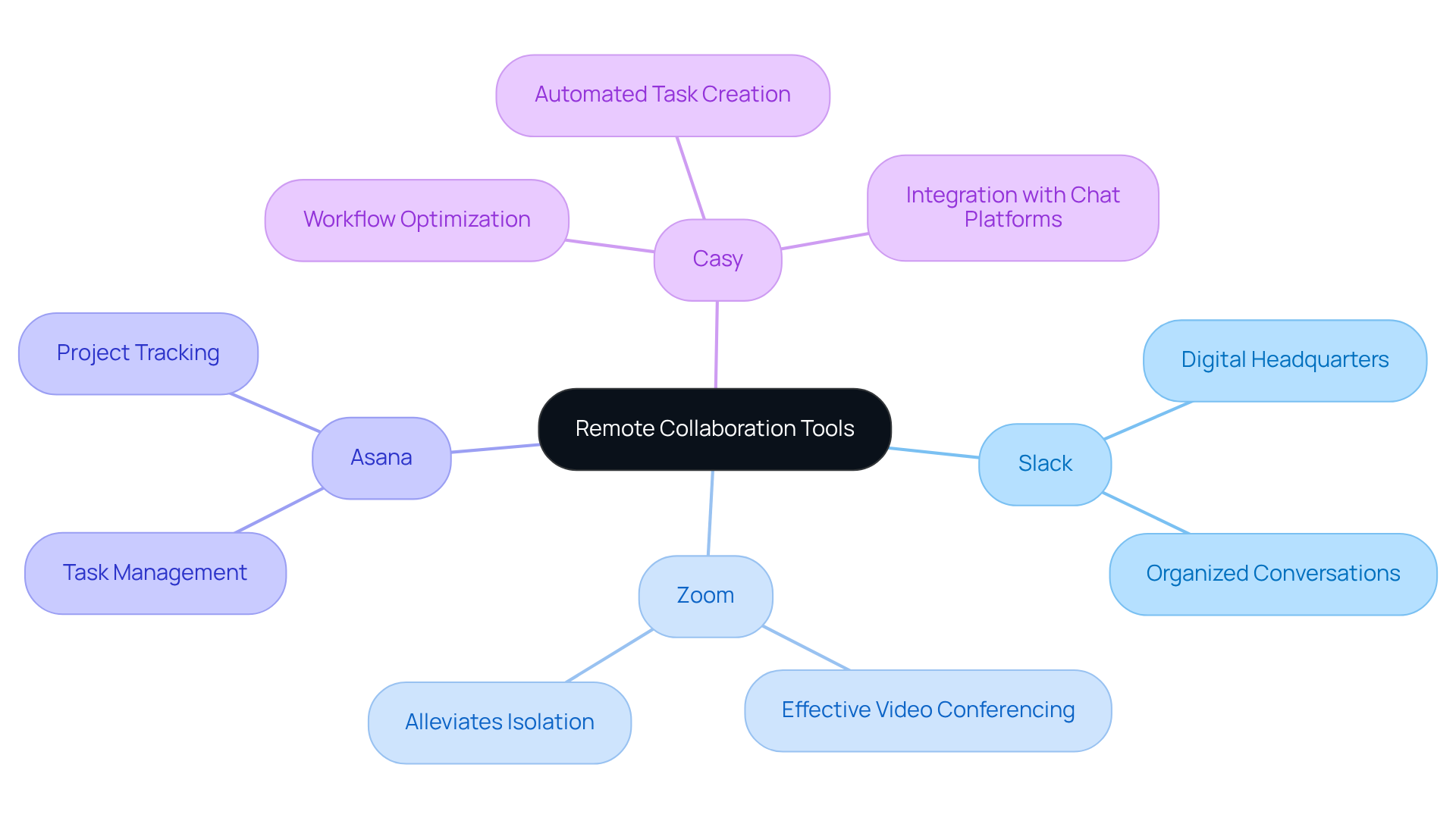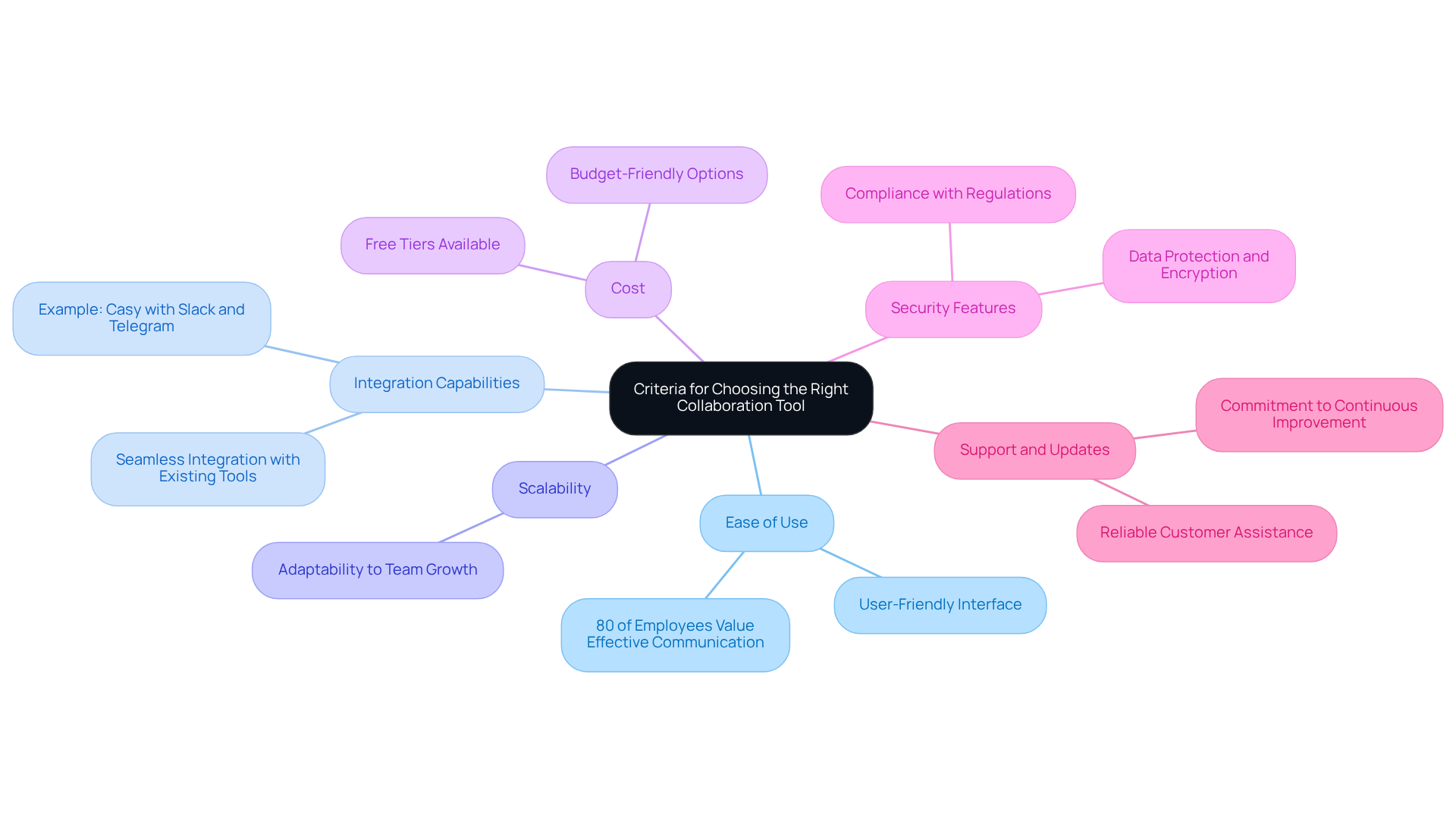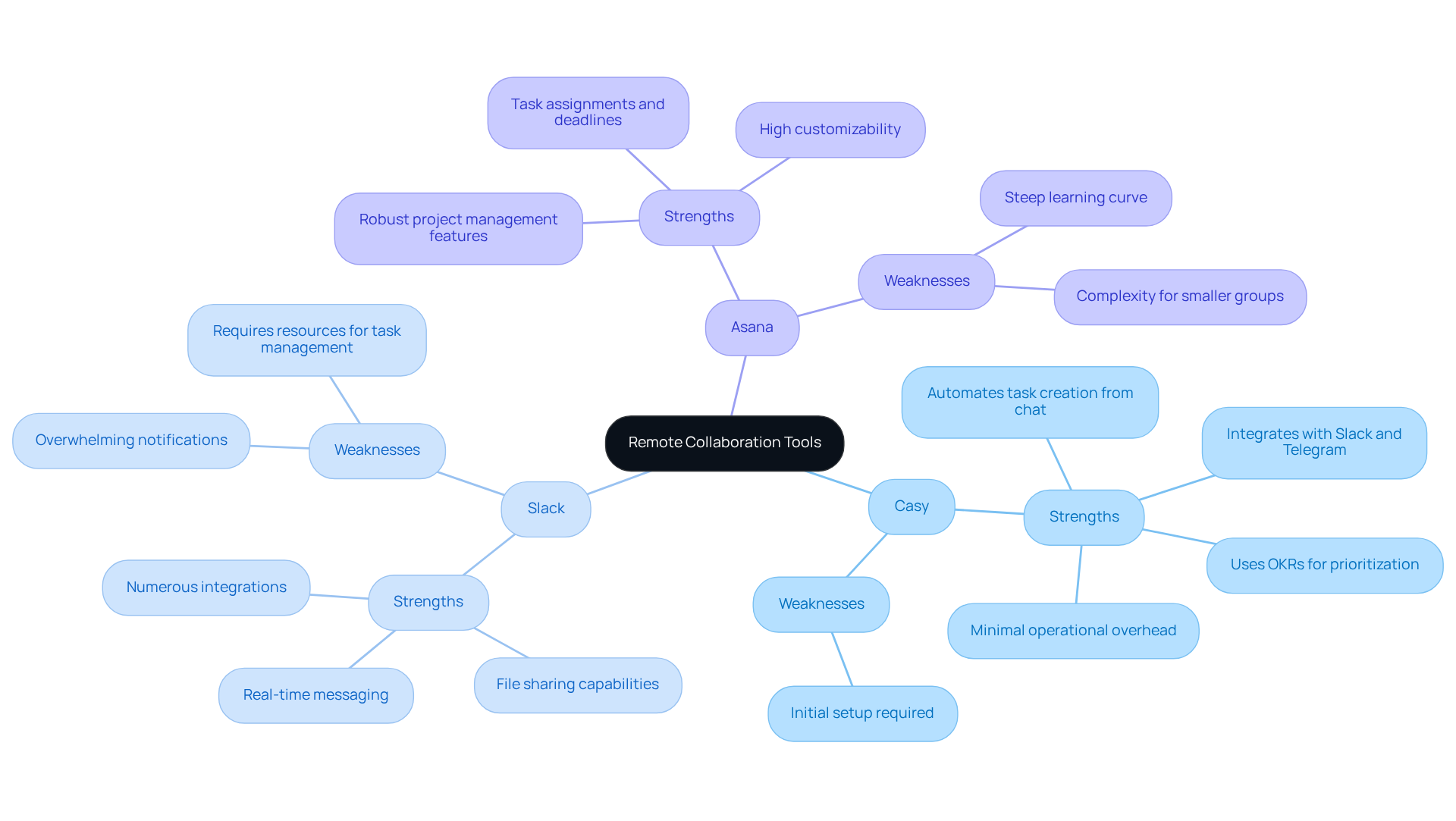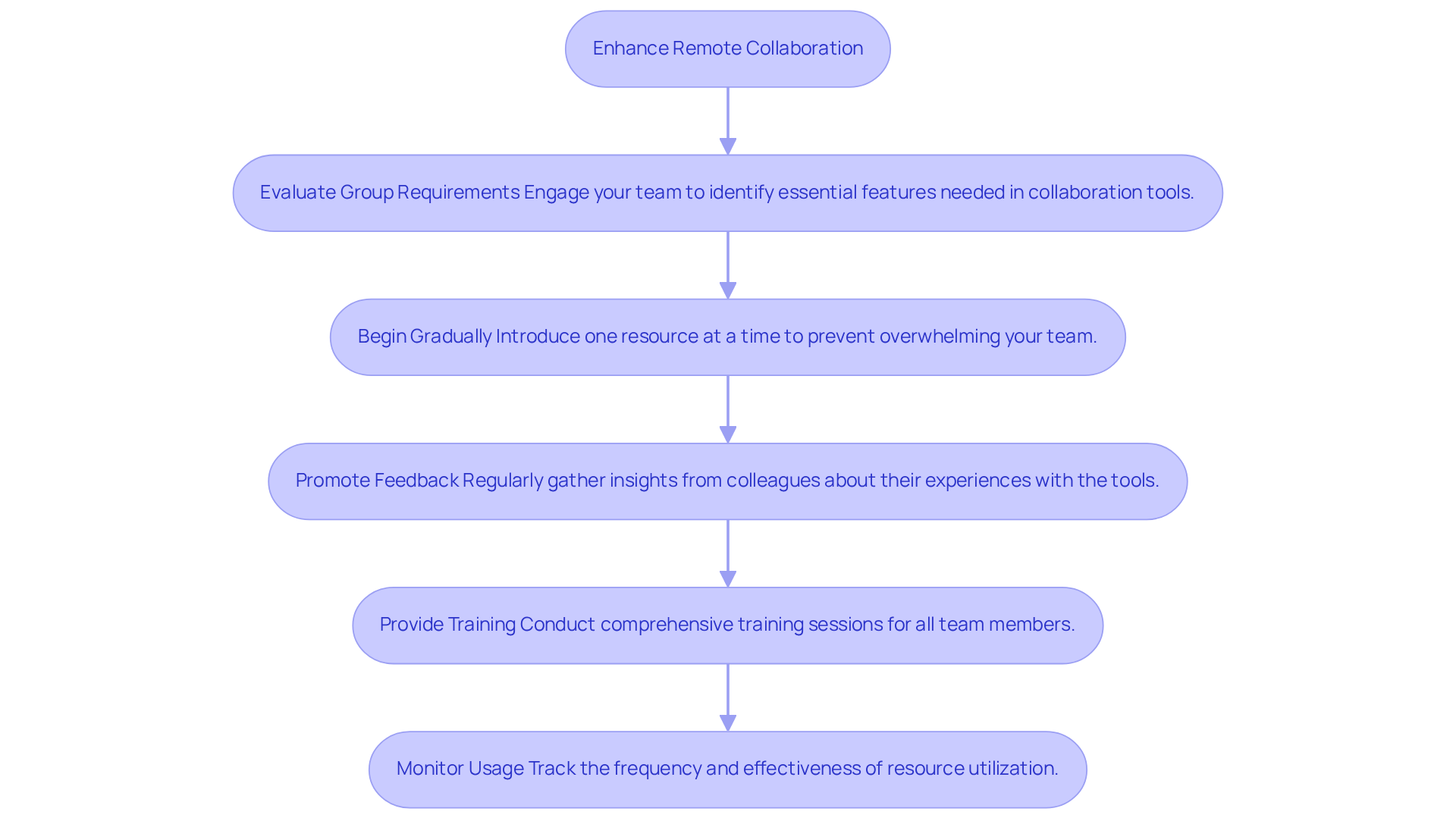Overview
The article explores four essential remote collaboration tools—Casy, Slack, and Asana—that are pivotal for startup success in a remote work environment. These tools significantly enhance communication, project management, and team cohesion. Notably, Casy’s automation features streamline workflows, supporting startups in optimizing productivity and fostering innovation.
How can these tools transform your startup's operations? By leveraging their capabilities, founders can address common challenges in remote collaboration. Casy, with its unique features, stands out as a game-changer, enabling teams to work more efficiently and creatively.
In conclusion, adopting these tools is not merely beneficial; it is crucial for startups aiming to thrive in today’s competitive landscape. Embrace the power of Casy, Slack, and Asana to elevate your team's performance and drive innovation forward.
Introduction
Remote collaboration tools have emerged as the backbone of modern teamwork, facilitating seamless communication and project management for teams distributed across various locations. As startups navigate the complexities of remote work, understanding which tools can enhance productivity and foster collaboration is essential. With a plethora of options available, how can founders determine which tools will truly meet their needs and drive success?
This article explores the top remote collaboration tools, highlighting their unique features and the criteria for selecting the right fit. Ultimately, it aims to guide startups toward effective and efficient teamwork in an increasingly digital landscape.
Understanding Remote Collaboration Tools
Remote collaboration tools are essential software programs that enable teamwork among individuals who are not physically present together. These remote collaboration tools significantly enhance communication, project management, file sharing, and real-time collaboration, making them indispensable for remote teams. Popular platforms such as Slack streamline messaging, Zoom enables effective video conferencing, and Asana supports task management, each providing unique features designed to cater to various collaboration needs. For example, Slack acts as a digital headquarters for organized conversations, while Zoom promotes face-to-face interactions that can alleviate feelings of isolation among remote workers.
In addition to these tools, Casy stands out as an innovative project management solution that optimizes workflows by integrating with chat platforms like Slack and Telegram. By automatically capturing essential information from discussions, Casy generates tasks, establishes deadlines, and updates documents without the need for manual input, addressing common pain points such as the burden of manual updates and the constant need for coordination. As more businesses adopt hybrid work models—58% of employees express a preference for this arrangement—understanding and effectively employing these resources is crucial for optimizing workflows and enhancing productivity.
Successful case studies indicate that new ventures leveraging these resources, including Casy, witness significant improvements in team cohesion and project outcomes, ultimately driving their success in a competitive landscape. By incorporating remote collaboration tools into their operations, startups can streamline processes and foster a culture of innovation and adaptability, which is vital for thriving in today’s dynamic work environment.

Criteria for Choosing the Right Collaboration Tool
When selecting remote collaboration tools, startups must prioritize several key criteria to ensure effective teamwork and operational efficiency.
-
Ease of Use: An intuitive device minimizes the need for extensive training. A user-friendly interface can significantly enhance team adoption and productivity. Did you know that 80% of employees believe effective communication is vital in the workplace? This statistic underscores the importance of usability in collaborative resources.
-
Integration Capabilities: Smooth integration with existing resources and platforms is crucial. Startups often rely on various applications, and a solution that integrates effortlessly can enhance workflows and reduce friction. For example, Casy integrates with chat platforms like Slack and Telegram, automating task creation and updates, which exemplifies effective integration.
-
Scalability: As teams grow, the collaboration platform must adapt to increased demands. Startups should select solutions that can scale without compromising performance or usability.
-
Cost: Budget constraints are a reality for new businesses. It is essential to assess pricing models and choose resources that offer the best value for their features. Numerous partnership resources provide free tiers or economical options, making them accessible for startups.
-
Security Features: With data sensitivity at the forefront, robust security measures are non-negotiable. Tools must ensure data protection through encryption and compliance with regulations.
-
Support and Updates: Reliable customer assistance and regular updates are essential for maintaining resource effectiveness. Startups should seek providers that offer responsive support and a commitment to continuous improvement.
By integrating these criteria, startups can make informed choices when selecting partnership resources, ultimately enhancing their operational efficiency and team cohesion using remote collaboration tools. However, it is crucial to recognize challenges related to teamwork software, such as integration issues and user fatigue, which can impact the selection process.

Comparative Analysis of Top Remote Collaboration Tools
In this comparative analysis, we delve into three leading remote collaboration tools: Casy, Slack, and Asana.
Casy:
- Strengths: This tool excels in automating task creation directly from chat discussions, integrates seamlessly with platforms like Slack and Telegram, and employs methodologies such as OKRs for effective prioritization. It is particularly advantageous for teams that desire minimal operational overhead.
- Weaknesses: However, it may necessitate an initial setup to align with existing workflows.
Slack:
- Strengths: Renowned for its real-time messaging capabilities and file sharing, Slack offers numerous integrations that foster rapid communication and collaboration among team members.
- Weaknesses: On the downside, the influx of notifications can be overwhelming, and it may require additional resources for comprehensive task management.
Asana:
- Strengths: Asana stands out with its robust project management features, including task assignments, deadlines, and progress tracking. Its high customizability makes it suitable for a diverse range of project types.
- Weaknesses: Yet, the learning curve can be steep for newcomers, and it may present unnecessary complexity for smaller groups.
Ultimately, each remote collaboration tool provides unique advantages tailored to different group needs. It is essential for new businesses to carefully assess their specific requirements before making a decision.

Recommendations for Startup Founders
To enhance remote collaboration, startup founders should consider the following strategies:
-
Evaluate Group Requirements: Engage your team through surveys or discussions to identify the essential features they need in collaboration resources. This ensures that the selected remote collaboration tools align with actual needs, which promotes better adoption. As remote startups benefit from reduced overhead costs, understanding group requirements can lead to more effective selection of remote collaboration tools.
-
Begin Gradually: Introduce one resource at a time to prevent overwhelming your team. The use of remote collaboration tools during gradual implementation facilitates smoother transitions and helps teams adapt without disruption. This approach is crucial in a remote work environment where remote collaboration tools make flexibility paramount.
-
Promote Feedback: Regularly gather insights from colleagues about their experiences with the tools. This feedback loop is essential for making informed adjustments and ensuring that the remote collaboration tools are effective and user-friendly. Asynchronous communication can enhance this process, allowing team members to provide feedback at their convenience.
-
Provide Training: Conduct comprehensive training sessions for all team members on effectively utilizing the resources. Proper training maximizes the potential of remote collaboration tools, thereby boosting overall productivity. For example, Casy's automated task creation feature can be highlighted during training to demonstrate its advantages.
-
Monitor Usage: Track the frequency and effectiveness of resource utilization. Analyzing this data helps refine your approach and ensures that the tools meet the team's needs. By monitoring usage, founders can confirm that their investment in remote collaboration tools yields the desired results.
By implementing these recommendations, founders can foster a cohesive and productive remote work environment, ultimately driving team success. As one founder noted, "If you’re building a startup, it’s time to embrace the remote work revolution — not just as a trend, but as your default operating system.

Conclusion
Effective remote collaboration tools are pivotal for the success of startups. They enable seamless communication, project management, and teamwork among distributed teams. By leveraging platforms like Slack, Zoom, Asana, and the innovative Casy, startups can optimize their workflows and foster an environment conducive to collaboration and productivity.
The importance of selecting the right tools cannot be overstated. Startups should consider criteria such as:
- Ease of use
- Integration capabilities
- Scalability
- Cost
- Security features
- Support
Each tool presents distinct strengths and weaknesses, making it essential for startups to align their specific needs with the functionalities of these platforms. Thoughtful implementation of these tools can lead to improved team cohesion and project outcomes.
In a world where remote work is becoming the norm, embracing the right collaboration tools is not merely advantageous; it is imperative for thriving in a competitive landscape. Startups must assess their unique requirements, gradually introduce tools, gather feedback, and provide adequate training to maximize the benefits of remote collaboration. By doing so, they can cultivate a culture of innovation and adaptability that is crucial for long-term success.
Frequently Asked Questions
What are remote collaboration tools?
Remote collaboration tools are software programs that enable teamwork among individuals who are not physically present together, enhancing communication, project management, file sharing, and real-time collaboration.
What are some popular remote collaboration tools?
Popular remote collaboration tools include Slack for messaging, Zoom for video conferencing, and Asana for task management, each offering unique features tailored to various collaboration needs.
How does Slack function as a remote collaboration tool?
Slack serves as a digital headquarters for organized conversations, allowing team members to communicate efficiently and keep discussions focused.
What is the role of Zoom in remote collaboration?
Zoom facilitates effective video conferencing, promoting face-to-face interactions that can help alleviate feelings of isolation among remote workers.
What is Casy, and how does it enhance project management?
Casy is an innovative project management solution that integrates with chat platforms like Slack and Telegram, automatically capturing essential information from discussions to generate tasks, establish deadlines, and update documents without manual input.
Why is it important to use remote collaboration tools in hybrid work models?
With 58% of employees expressing a preference for hybrid work arrangements, effectively employing remote collaboration tools is crucial for optimizing workflows and enhancing productivity.
What benefits have businesses seen from using remote collaboration tools?
Successful case studies show that businesses leveraging remote collaboration tools, like Casy, experience significant improvements in team cohesion and project outcomes, driving their success in a competitive landscape.
How can remote collaboration tools impact startups?
By incorporating remote collaboration tools into their operations, startups can streamline processes and foster a culture of innovation and adaptability, which is vital for thriving in today’s dynamic work environment.




